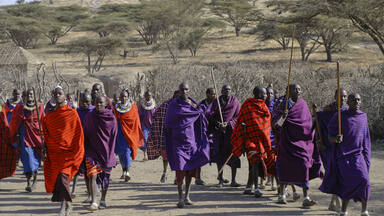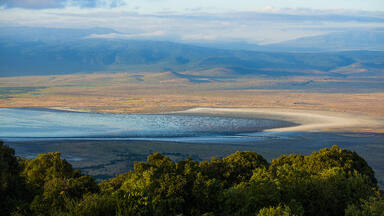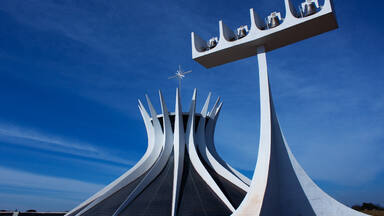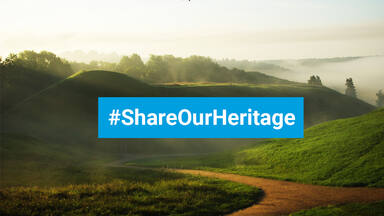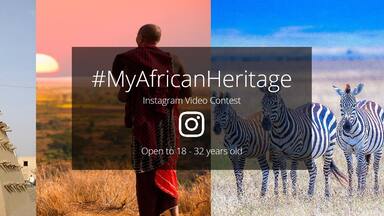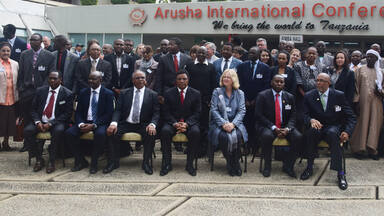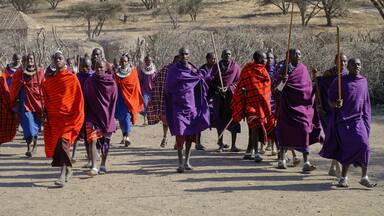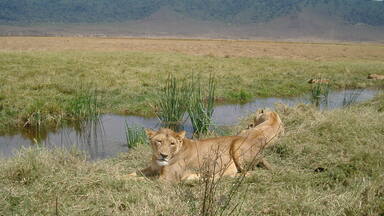Ngorongoro Conservation Area
Ngorongoro Conservation Area
The Ngorongoro Conservation Area spans vast expanses of highland plains, savanna, savanna woodlands and forests. Established in 1959 as a multiple land use area, with wildlife coexisting with semi-nomadic Maasai pastoralists practicing traditional livestock grazing, it includes the spectacular Ngorongoro Crater, the world’s largest caldera. The property has global importance for biodiversity conservation due to the presence of globally threatened species, the density of wildlife inhabiting the area, and the annual migration of wildebeest, zebra, gazelles and other animals into the northern plains. Extensive archaeological research has also yielded a long sequence of evidence of human evolution and human-environment dynamics, including early hominid footprints dating back 3.6 million years.
Description is available under license CC-BY-SA IGO 3.0
Zone de conservation de Ngorongoro
La zone de conservation de Ngorongoro s’étend sur de vastes étendues de prairies, de brousses et de forêts d’altitude. Etablie en 1959 en tant que zone d’usage multiple des terres, la faune sauvage coexistant avec des pasteurs Massaï semi-nomades pratiquant l’élevage du bétail, elle comprend le spectaculaire cratère du Ngorongoro, la plus grande caldeira du monde. Le bien revêt une importance mondiale pour la conservation de la biodiversité, du fait de la présence d’espèces menacées à l’échelle mondiale, de la densité de la faune sauvage qui y vit tout au long de l’année, et de la migration annuelle des gnous, zèbres, gazelles de Thomson et gazelles de Grant et autres ongulés vers les plaines du nord. Des fouilles archéologiques de grande envergure ont livré une longue séquence de traces de l’évolution humaine et de la dynamique homme-environnement dont des empreintes de pas fossilisées datant de 3.6 millions d’années.
Description is available under license CC-BY-SA IGO 3.0
منطقة نغورونغورو المحمية
تشكل فوهة نغورونغورو الهائلة ملاذاً دائماً لعدد كبير من الحيوانات البرية. وتقع على مقربة منها فوهة إيمباكاي ببحيرتها العميقة وبركان أولدونيو لينغاي الذي لا يزال ناشطاً. وعلى مسافة ليست ببعيدة، سمحت الحفريات في شعب الدوفاي باكتشاف عظام تعود الى الإنسان الحذق، كما نجد في موقع لايتولي من المنطقة نفسها آثار أقدام القردة العليا الأولى التي عاشت منذ 3.6 ملايين سنة.
source: UNESCO/CPE
Description is available under license CC-BY-SA IGO 3.0
恩戈罗恩戈罗自然保护区
巨大完整的恩戈罗恩戈罗火山口是野生动物出没的地方,附近是注满了深水的恩帕卡艾火山口和盖伦活火山。在距此不远的奥杜瓦伊山谷的挖掘工作中,发现了人类的远祖之一哈比利斯人的遗址,Laitoli遗址也在该区域内,它也是360多万年前原始人类活动的主要区域之一。
source: UNESCO/CPE
Description is available under license CC-BY-SA IGO 3.0
Охраняемая область Нгоронгоро
Огромные и постоянные скопления диких животных можно обнаружить внутри Нгоронгоро – гигантского и хорошо сохранившегося вулканического кратера. Поблизости расположены вулкан Эмпакаи, с кратером, заполненным глубоким озером, и действующий вулкан Олдонио-Ленгаи. В Олдовайском ущелье обнаружены ископаемые остатки одного из наших далеких предков – человека умелого (Homo habilis). Латоли – это одно из важнейших местонахождений следов самых ранних гоминид, живших 3,6 млн. лет назад.
source: UNESCO/CPE
Description is available under license CC-BY-SA IGO 3.0
Zona de conservación de Ngorongoro
El inmenso y perfecto cráter de Ngorongoro alberga una gran abundancia de animales salvajes. En sus inmediaciones se encuentran el cráter de Empakaai, con un profundo lago, y el volcán Oldonyo Lengai, todavía en actividad. No muy lejos, en la garganta de Olduvai, las excavaciones efectuadas han permitido descubrir restos óseos de uno de los antepasados más lejanos del hombre, el homo habilis. Situado en esta misma región, el sitio de Laitoli posee huellas de pisadas de los primeros homínidos, que datan de 3,6 millones de años atrás.
source: UNESCO/CPE
Description is available under license CC-BY-SA IGO 3.0
ンゴロンゴロ保全地域
世界で2番目に広いカルデラをもつンゴロンゴロ山を中心とした保全地域には、絶滅の危機に瀕しているシロサイを含む、多くの野生動物が生息している。周辺に住むマサイの人々はこの地域で遊牧を行っており、動物と人間が共存しながら、自然を守るという保全地域のようすがよくわかる。絶滅の危機に瀕するシロサイをはじめ、多くの野生動物が生息し、カルデラ湖や活火山も見られる。2010年にオルドバイ渓谷の人類の遠い祖先ホモ・ハビリスの化石やライトリの360万年前の人類の足跡化石の考古学的価値が評価され、複合遺産となった。source: NFUAJ
Beschermd gebied Ngorongoro
Het Beschermd gebied Ngorongoro bestaat uit uitgestrekte hoogvlakten, savannes, savannebossen en wouden. Het is een zelfstandig natuurgebied sinds 1959 en kent meervoudig landgebruik, het is zowel een natuurpark als een plek waar de semi-nomadische Masaï hun vee laten grazen. In het park bevindt zich ’s werelds grootste caldera, de spectaculaire Ngorongoro krater. Er leven veel bedreigde diersoorten en het gebied is daarom van groot belang voor het behoud van biodiversiteit. Bijzonder is de jaarlijkse migratie van gnoes, zebra's, gazellen en andere dieren in de noordelijke vlakten. Uitgebreid archeologisch onderzoek heeft aangetoond dat dit gebied al heel lang geleden door mensachtigen bewoond werd. Zo zijn er voetafdrukken gevonden die dateren van zo’n 3,6 miljoen jaar geleden.
Source: unesco.nl
Outstanding Universal Value
Brief synthesis
The Ngorongoro Conservation Area (809,440 ha) spans vast expanses of highland plains, savanna, savanna woodlands and forests, from the plains of the Serengeti National Park in the north-west, to the eastern arm of the Great Rift Valley. The area was established in 1959 as a multiple land use area, with wildlife coexisting with semi-nomadic Maasai pastoralists practising traditional livestock grazing. It includes the spectacular Ngorongoro Crater, the world's largest caldera, and Olduvai Gorge, a 14km long deep ravine. The property has global importance for biodiversity conservation in view of the presence of globally threatened species such as the black Rhino, the density of wildlife inhabiting the Ngorongoro Crater and surrounding areas throughout the year, and the annual migration of wildebeest, zebra, Thompson's and Grant's gazelles and other ungulates into the northern plains.
The area has been subject to extensive archaeological research for over 80 years and has yielded a long sequence of evidence of human evolution and human-environment dynamics, collectively extending over a span of almost four million years to the early modern era. This evidence includes fossilized footprints at Laetoli, associated with the development of human bipedalism, a sequence of diverse, evolving hominin species within Olduvai gorge, which range from Australopiths such as Zinjanthropus boisei to the Homo lineage that includes Homo habilis, Homo erectus and Homo sapiens; an early form of Homo sapiens at Lake Ndutu; and, in the Ngorongoro crater, remains that document the development of stone technology and the transition to the use of iron. The overall landscape of the area is seen to have the potential to reveal much more evidence concerning the rise of anatomically modern humans, modern behavior and human ecology.
Criterion (iv): Ngorongoro Conservation Area has yielded an exceptionally long sequence of crucial evidence related to human evolution and human-environment dynamics, collectively extending from four million years ago to the beginning of this era, including physical evidence of the most important benchmarks in human evolutionary development. Although the interpretation of many of the assemblages of Olduvai Gorge is still debatable, their extent and density are remarkable. Several of the type fossils in the hominin lineage come from this site. Furthermore, future research in the property is likely to reveal much more evidence concerning the rise of anatomically modern humans, modern behavior and human ecology.
Criterion (vii): The stunning landscape of Ngorongoro Crater combined with its spectacular concentration of wildlife is one of the greatest natural wonders of the planet. Spectacular wildebeest numbers (well over 1 million animals) pass through the property as part of the annual migration of wildebeest across the Serengeti ecosystem and calve in the short grass plains which straddle the Ngorongoro Conservation Area/Serengeti National Park boundary. This constitutes a truly superb natural phenomenon.
Criterion (viii): Ngorongoro crater is the largest unbroken caldera in the world. The crater, together with the Olmoti and Empakaai craters are part of the eastern Rift Valley, whose volcanism dates back to the late Mesozoic / early Tertiary periods and is famous for its geology. The property also includes Laetoli and Olduvai Gorge, which contain an important palaeontological record related to human evolution.
Criterion (ix): The variations in climate, landforms and altitude have resulted in several overlapping ecosystems and distinct habitats, with short grass plains, highland catchment forests, savanna woodlands, montane long grass plains and high open moorlands. The property is part of the Serengeti ecosystem, one of the last intact ecosystems in the world which harbours large and spectacular animal migrations.
Criterion (x): Ngorongoro Conservation Area is home to a population of some 25,000 large animals, mostly ungulates, alongside the highest density of mammalian predators in Africa including the densest known population of lion (estimated 68 in 1987). The property harbours a range of endangered species, such as the Black Rhino, Wild hunting dog and Golden Cat and 500 species of birds. It also supports one of the largest animal migrations on earth, including over 1 million wildebeest, 72,000 zebras and c.350,000 Thompson and Grant gazelles.
Integrity
The property was inscribed under natural criteria (vii), (viii), (ix) and (x) in 1979 and under cultural criterion (iv) in 2010. Thus, the statement of integrity reflects integrity for natural values at the date of inscription of 1979, and for the cultural value in 2010.
In relation to natural values, the grasslands and woodlands of the property support very large animal populations, largely undisturbed by cultivation at the time of inscription. The wide-ranging landscapes of the property were not impacted by development or permanent agriculture at the time of inscription. The integrity of the property is also enhanced by being part of Serengeti - Mara ecosystem. The property adjoins Serengeti National Park (1,476,300 ha), which is also included on the World Heritage List as a natural property. Connectivity within and between these properties and adjoining landscapes, through functioning wildlife corridors is essential to protect the integrity of animal migrations. No hunting is permitted in Ngorongoro Conservation Area (NCA), but poaching of wildlife is a continuing threat, requiring effective patrolling and enforcement capacity. Invasive species are a source of ongoing concern, requiring continued monitoring and effective action if detected. Tourism pressure is also of concern, including in relation to the potential impacts from increased visitation, new infrastructure, traffic, waste management, disturbance to wildlife and the potential for introduction of invasive species.
The property provides grazing land for semi-nomadic Maasai pastoralists. At the time of inscription an estimated 20,000 Maasai were living in the property, with some 275,000 head of livestock, which was considered within the capacity of the reserve. No permanent agriculture is officially allowed in the property. Further growth of the Maasai population and the number of cattle should remain within the capacity of the property, and increasing sedentarisation, local overgrazing and agricultural encroachment are threats to both the natural and cultural values of the property. There were no inhabitants in Ngorongoro and Empaakai Craters or the forest at the time of inscription in 1979.
The property encompasses not only the known archaeological remains but also areas of high archaeo-anthropological potential where related finds might be made. However the integrity of specific paleo-archaeological attributes and the overall sensitive landscape are to an extent under threat and thus vulnerable due to the lack of enforcement of protection arrangements related to grazing regimes, and from proposed access and tourist related developments at Laetoli and Olduvai Gorge.
Authenticity
In general, the authenticity of the fossil localities is unquestionable, however given the nature of fossil sites, the context for the fossil deposits needs to remain undisturbed (except by natural geological processes). As the nomination dossier does not contain sufficient detailed information on most of the sites to delineate their extended areas or the areas of archaeological sensitivity, or sufficient guarantees in terms of management arrangements to ensure that the sites will remain undisturbed and not threatened by visitor access, construction or grazing cattle, their authenticity is vulnerable.
Protection and management requirements
The primary legislation protecting the property is the Ngorongoro Conservation Area Ordinance of 1959. The property is under the management of the Ngorongoro Conservation Area Authority (NCAA). The Division of Antiquities is responsible for the management and protection of the paleo-anthropological resources within the Ngorongoro Conservation Area. A memorandum of understanding should be established and maintained to formally establish the relations between the two entities.
Property management is guided by a General Management Plan. Currently, the primary management objectives are to conserve the natural resources of the property, protect the interests of the Maasai pastoralists, and to promote tourism. The management system and the Management Plan need to be widened to encompass an integrated cultural and natural approach, bringing together ecosystem needs with cultural objectives in order to achieve a sustainable approach to conserving the Outstanding Universal Value of the property, including the management of grasslands and the archaeological resource, and to promote environmental and cultural awareness. The Plan needs to extend the management of cultural attributes beyond social issues and the resolution of human-wildlife conflicts to the documentation, conservation and management of the cultural resources and the investigation of the potential of the wider landscape in archaeological terms.
It is particularly important that NCAA has the capacity and specialist skills to ensure the effectiveness of its multiple-use regime, including knowledge of management of pastoral use in partnership with the Maasai community and other relevant stakeholders. There is also a need for NCAA to ensure staff have skills in natural and cultural heritage to achieve well designed, integrated and effective conservation strategies, including effective planning of tourism, access and infrastructure.
A thorough understanding of the capacity of the property to accommodate human use and livestock grazing is required, based on the needs of the Maasai population and the assessment of the impact of the human populations on the ecosystems and archaeology of the property. An agreed joint strategy between the NCAA, Maasai community leaders as well as other stakeholders, is required to ensure human population levels, and levels of resource use are in balance with the protection of its natural and cultural attributes, including in relation to grazing and grassland management, and the avoidance of human-wildlife conflict. The active participation of resident communities in decision-making processes is essential, including the development of benefit-sharing mechanisms to encourage a sense of ownership of, and responsibility for, the conservation and sustainable use of the property's natural and cultural resources.
An overall tourism strategy for the property is a long term requirement, to both guide the public use of the property and ways of presenting the property, and to prioritize the quality of the tourism experience, rather than the quantity of visitors and tourism facilities. Vehicle access to the crater and other popular areas of the property requires clear limits to protect the quality of experience of the property and to ensure natural and cultural attributes are not unduly disturbed. Developments and infrastructure for tourism or management of the property that impinge on its natural and cultural attributes should not be permitted.
Considering the important relationship, in natural terms of the property to adjoining reserves, it is important to establish effective and continuing collaboration between the property, Serengeti National Park, and other areas of the Serengeti-Mara ecosystem to assure connectivity for wildlife migrations, and harmonize management objectives regarding tourism use, landscape management and sustainable development.
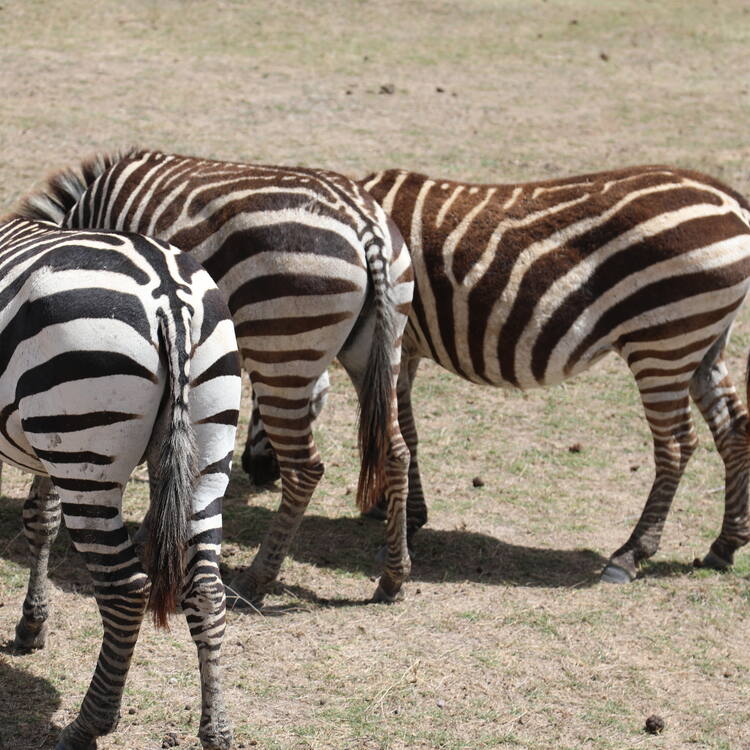
 View photos from OUR PLACE the World Heritage collection
View photos from OUR PLACE the World Heritage collection
